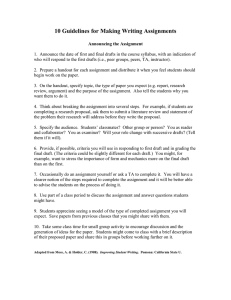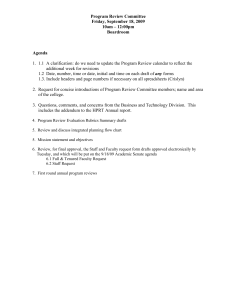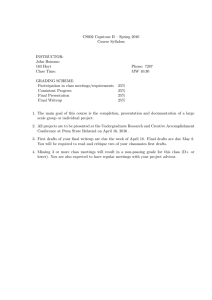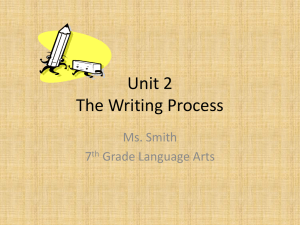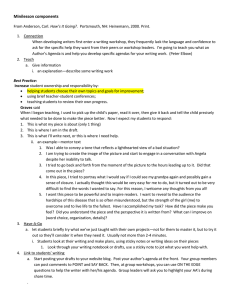Sample Case Study: Embedded Assessment Applied to Student Learning
advertisement
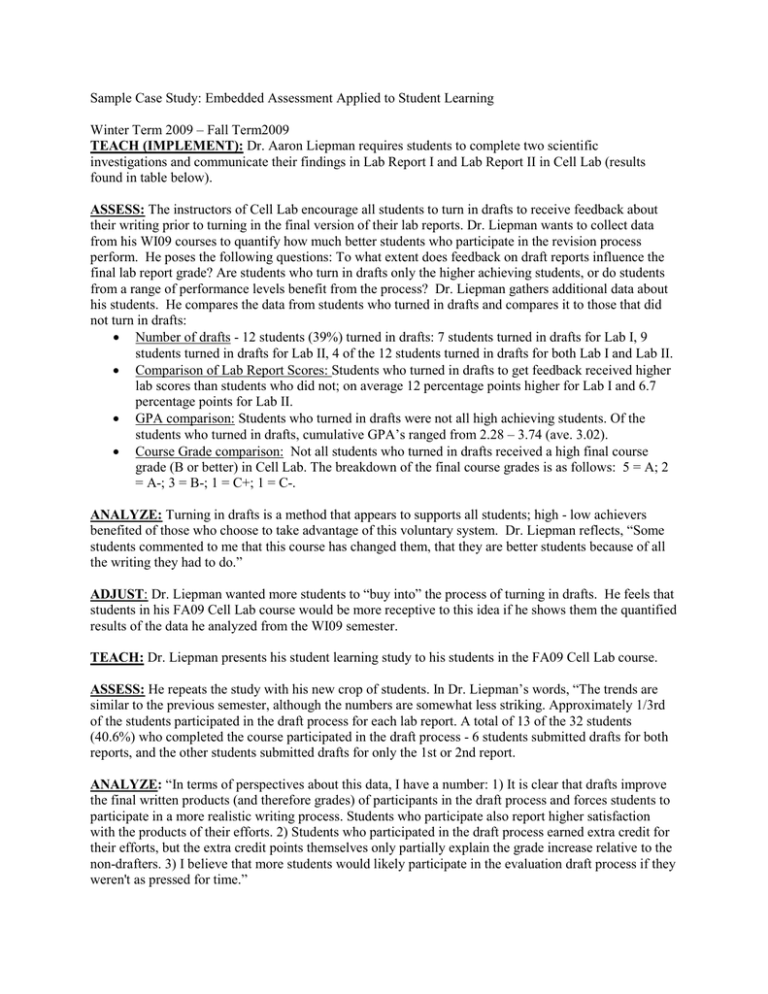
Sample Case Study: Embedded Assessment Applied to Student Learning Winter Term 2009 – Fall Term2009 TEACH (IMPLEMENT): Dr. Aaron Liepman requires students to complete two scientific investigations and communicate their findings in Lab Report I and Lab Report II in Cell Lab (results found in table below). ASSESS: The instructors of Cell Lab encourage all students to turn in drafts to receive feedback about their writing prior to turning in the final version of their lab reports. Dr. Liepman wants to collect data from his WI09 courses to quantify how much better students who participate in the revision process perform. He poses the following questions: To what extent does feedback on draft reports influence the final lab report grade? Are students who turn in drafts only the higher achieving students, or do students from a range of performance levels benefit from the process? Dr. Liepman gathers additional data about his students. He compares the data from students who turned in drafts and compares it to those that did not turn in drafts: • Number of drafts - 12 students (39%) turned in drafts: 7 students turned in drafts for Lab I, 9 students turned in drafts for Lab II, 4 of the 12 students turned in drafts for both Lab I and Lab II. • Comparison of Lab Report Scores: Students who turned in drafts to get feedback received higher lab scores than students who did not; on average 12 percentage points higher for Lab I and 6.7 percentage points for Lab II. • GPA comparison: Students who turned in drafts were not all high achieving students. Of the students who turned in drafts, cumulative GPA’s ranged from 2.28 – 3.74 (ave. 3.02). • Course Grade comparison: Not all students who turned in drafts received a high final course grade (B or better) in Cell Lab. The breakdown of the final course grades is as follows: 5 = A; 2 = A-; 3 = B-; 1 = C+; 1 = C-. ANALYZE: Turning in drafts is a method that appears to supports all students; high - low achievers benefited of those who choose to take advantage of this voluntary system. Dr. Liepman reflects, “Some students commented to me that this course has changed them, that they are better students because of all the writing they had to do.” ADJUST: Dr. Liepman wanted more students to “buy into” the process of turning in drafts. He feels that students in his FA09 Cell Lab course would be more receptive to this idea if he shows them the quantified results of the data he analyzed from the WI09 semester. TEACH: Dr. Liepman presents his student learning study to his students in the FA09 Cell Lab course. ASSESS: He repeats the study with his new crop of students. In Dr. Liepman’s words, “The trends are similar to the previous semester, although the numbers are somewhat less striking. Approximately 1/3rd of the students participated in the draft process for each lab report. A total of 13 of the 32 students (40.6%) who completed the course participated in the draft process - 6 students submitted drafts for both reports, and the other students submitted drafts for only the 1st or 2nd report. ANALYZE: “In terms of perspectives about this data, I have a number: 1) It is clear that drafts improve the final written products (and therefore grades) of participants in the draft process and forces students to participate in a more realistic writing process. Students who participate also report higher satisfaction with the products of their efforts. 2) Students who participated in the draft process earned extra credit for their efforts, but the extra credit points themselves only partially explain the grade increase relative to the non-drafters. 3) I believe that more students would likely participate in the evaluation draft process if they weren't as pressed for time.” ADJUST: “It will be interesting to see if the percentage of students who participate in this process increases once Cell Lab becomes a 3 credit course. [Dr. Liepman was a leader in making this curriculum change for the undergraduate program based on his previous observations of the teaching/learning process in this course]. Since Cell Lab is currently a 2 credit course, I believe that many students register for it without fully appreciating the workload, and therefore opt to take it on top of an already heavy workload. Perhaps this trend will change once the course is worth 3 credits.” Program-Level Summative Assessment Information for Cell and Molecular and Genetics Laboratory. Winter 2009 and Fall 2009 Summary of Lab Reports I & II. Program-Level Outcome 2: Students will communicate scientific knowledge, concepts, experimental results and conclusions in written form. Assessment and Semester Lab Report I Lab Report I Lab Report II Lab Report II WI09 FA09 WI09 FA09 Scores for Students Who Turned in Lab Reports No. Reports Turned In No. Reports Not Turned In High Average Low 30 28 30 30 1 4 1 2 102% 102% 97% 101% 77.3% 80.6% 84.8% 85.3% 47% 62% 50% 71.5% # of Students Scoring Below 70% 5 5 3 0
